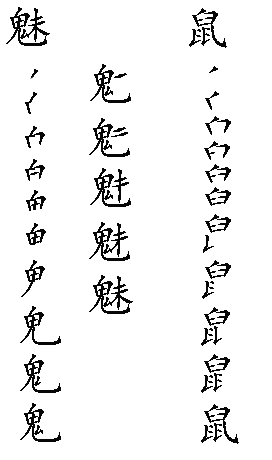| Strings of Fate | Zodiac Notes |
| Character Guide | Enrichment | Page Jump |
|Links | Contact |
| Intro | Systems | Characters | Phonetic Guides | Grammar | Common Idioms | The Character System
Chinese is a unique language because it is composed solely of characters. Originating in prehistoric rock carvings, characters have since evolved to represent abstract ideas as well as simple nouns. Each character has its own meaning, but it can also be combined with others to form words and idioms. Such a pictographic writing system was necessary to successfully govern a country composed mostly of rural villages and hundreds of local dialects. An official from Beijing can be sent to govern Canton without the trouble of translation. There has always been a "dialect of the capital", but that was merely for ease of communication between officials. The beauty of such a system is that it doesn't change much over millenia. The sounds might have changed, but the characters that were formallized 2000 years ago are still being commonly used today. Matching Character to Sound
Since each character is only one syllable long, there are only a set number of one-syllable sounds in the Chinese language. To help amend the fact, that several hundred sounds must encompass several thousand words, there are four tones to further divide each distinct syllable. In the end you have around 3-10 homophones for each toned syllable. Then there's the other way around: some characters have multiple sounds, often differentiating between the verb usage and the noun usage. For example the Chinese word for "and", "he", takes the second tone ("huh?") to mean "and" or "calm", but it takes the fourth tone ("huh!") to mean "harmonize". It also takes the second tone of hu ("who?") when referring to victory in mahjong. But when it is pronounced as huo, it can mean "to knead" with the second tone ("huo?"), or with "to mix" the fourth tone ("huo!").Yeah, this all sounds confusing, but the specific character can usually be differentiated by the context and word combinations.
On the other hand, hu's third tone ("Hu=u", like Kuang Hu) can mean "tiger", "to bluff", a mineral, and "by the side of a body of water". (This is a short one. There are 25 words listedn under hu's second tone, ranging from beard to fox to butterfly to paste to arc to pitcher.)Matching Sound to Character
So what if we think about it the other way? Now you know how to place characters to sounds, how do you place sounds to characters? Thankfully, most Chinese characters are composed of two base parts: the sound part, and the meaning part. The meaning part is called the "bu(4) shou(3)" ("boo!scho=oh"), and include simplified symbols such as "hand", "metal", "water", "wood", "clothing", "earth", etc. The sound part is usually a "base character", a character that can stand by itself, but is also used to guide the sound for other characters. Of course, the sound might not be exact. But it's usually pretty close, at most the difference between "jing(1)" and "qing(1)". For example, "Mao(1)" ("mall-"): the sound part is "miao(2)" ("miao?"), "sprout", while the bushou is the one for animals. If you add a "mouth-sound" bushou to miao instead, you get the sound that a cat makes: "miao(1)" ("meow-"). If you add a "metal" bushou, you get "anchor", or "mao(2)" ("mall?"). If you add an "eye" bushou, you get the verb "to peer", or "miao(1)", (miao-)So that isn't too bad, is it? There are patterns and sound devices to help with the pronounciation.Writing Chinese
Writing Chinese is mostly comprised of learning the different bushou and the base cases, and how to piece them together. This trait narrows the amount of words you have to memorize from 200 down to about 500. There are eight basic strokes that form all the tens of thousands of Chinese words: the dot, the vertical line, the horizonal line, the twist, the hook, the left diagonal, and the right diagonal. Stroke order is important, and the basic rule is to work from right to left, top to bottom, and outside to inside. For example, if I were to write "Meishuu", I would go about it this way:
| Strings of Fate | Zodiac Notes |
| Character Guide | Enrichment | Page Jump |
|Links | Contact |
